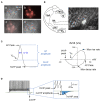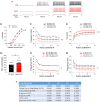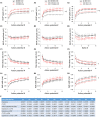Secondhand Smoke Decreased Excitability and Altered Action Potential Characteristics of Cardiac Vagal Neurons in Mice
- PMID: 34630146
- PMCID: PMC8498211
- DOI: 10.3389/fphys.2021.727000
Secondhand Smoke Decreased Excitability and Altered Action Potential Characteristics of Cardiac Vagal Neurons in Mice
Abstract
Background: Secondhand smoke (SHS), a major indoor pollutant, is a significant risk factor for cardiovascular morbidity and mortality including arrhythmias and sudden cardiac death. Exposure to SHS can produce autonomic imbalance, as evidenced by reduced heart rate variability (HRV)-a clinical metric of cardiac vagal regulation. Currently, the mechanisms through which SHS changes the vagal preganglionic neuronal inputs to the heart to produce this remains unknown. Objectives: To characterize the effect of SHS on both the excitability and action potential (AP) characteristics of anatomically identified cardiac vagal neurons (CVNs) in the nucleus ambiguus and examine whether SHS alters small conductance calcium-activated potassium (SK) channel activity of these CVNs. Methods: Adult male mice were exposed to four weeks of filtered air or SHS (3 mg/m3) 6 h/day, 5 day/week. Using patch-clamp recordings on identified CVNs in brainstem slices, we determined neuronal excitability and AP characteristics with depolarizing step- and ramp-current injections. Results: Four weeks of SHS exposure reduced spiking responses to depolarizing current injections and increased AP voltage threshold in CVNs. Perfusion with apamin (20 nM) magnified these SHS-induced effects, suggesting reduced SK channel activity may serve to minimize the SHS-induced decreases in CVNs excitability. Medium afterhyperpolarization (a measurement of SK channel activity) was smaller in the SHS group, further supporting a lower SK channel activity. AP amplitude, rise rate, fast afterhyperpolarization amplitude (a measurement of voltage-gated channel activity), and decay rate were higher in the SHS group at membrane voltages more positive to 0 mV, suggesting altered inactivation properties of voltage-dependent channels underlying APs. Discussion: SHS exposure reduced neuronal excitability of CVNs with compensatory attenuation of SK channel activity and altered AP characteristics. Neuroplasticity of CVNs could blunt regulatory cardiac vagal signaling and contribute to the cardiovascular consequences associated with SHS exposure, including reduced HRV.
Keywords: SK channel; autonomic function; cardiovascular; environmental tobacco smoke; neuroplasticity; nucleus ambiguus; spiking activity.
Copyright © 2021 Sun, Pan, Karey, Chen, Pinkerton, Wilson and Chen.
Conflict of interest statement
The authors declare that the research was conducted in the absence of any commercial or financial relationships that could be construed as a potential conflict of interest.
Figures











Similar articles
-
Small conductance Ca2+-activated K+ channels regulate firing properties and excitability in parasympathetic cardiac motoneurons in the nucleus ambiguus.Am J Physiol Cell Physiol. 2010 Dec;299(6):C1285-98. doi: 10.1152/ajpcell.00134.2010. Epub 2010 Aug 25. Am J Physiol Cell Physiol. 2010. PMID: 20739619 Free PMC article.
-
Characteristics of single large-conductance Ca2+-activated K+ channels and their regulation of action potentials and excitability in parasympathetic cardiac motoneurons in the nucleus ambiguus.Am J Physiol Cell Physiol. 2014 Jan 15;306(2):C152-66. doi: 10.1152/ajpcell.00423.2012. Epub 2013 Nov 6. Am J Physiol Cell Physiol. 2014. PMID: 24196530 Free PMC article.
-
Maternal diabetes increases large conductance Ca2+-activated K+ outward currents that alter action potential properties but do not contribute to attenuated excitability of parasympathetic cardiac motoneurons in the nucleus ambiguus of neonatal mice.Am J Physiol Regul Integr Comp Physiol. 2011 May;300(5):R1070-8. doi: 10.1152/ajpregu.00470.2010. Epub 2011 Jan 19. Am J Physiol Regul Integr Comp Physiol. 2011. PMID: 21248308 Free PMC article.
-
Secondhand smoke exposure alters K+ channel function and intrinsic cell excitability in a subset of second-order airway neurons in the nucleus tractus solitarius of young guinea pigs.Eur J Neurosci. 2010 Feb;31(4):673-84. doi: 10.1111/j.1460-9568.2010.07093.x. Eur J Neurosci. 2010. PMID: 20384811
-
Small conductance Ca2+-activated K+ channels as targets of CNS drug development.Curr Drug Targets CNS Neurol Disord. 2004 Jun;3(3):161-7. doi: 10.2174/1568007043337472. Curr Drug Targets CNS Neurol Disord. 2004. PMID: 15180477 Review.
Cited by
-
Global burden of stroke attributable to secondhand smoke in 204 countries and territories from 1990 to 2019: analysis of the global burden of disease study.Front Neurol. 2024 Jan 26;15:1320033. doi: 10.3389/fneur.2024.1320033. eCollection 2024. Front Neurol. 2024. PMID: 38343713 Free PMC article.
-
Deep Learning-Based Electrocardiograph in Evaluating Radiofrequency Ablation for Rapid Arrhythmia.Comput Math Methods Med. 2022 Mar 23;2022:6491084. doi: 10.1155/2022/6491084. eCollection 2022. Comput Math Methods Med. 2022. PMID: 35371280 Free PMC article.
-
Effects of chronic secondhand smoke exposure on cardiovascular regulation and the role of soluble epoxide hydrolase in mice.Front Physiol. 2023 Jun 8;14:1185744. doi: 10.3389/fphys.2023.1185744. eCollection 2023. Front Physiol. 2023. PMID: 37362438 Free PMC article.
References
Grants and funding
LinkOut - more resources
Full Text Sources
Miscellaneous

